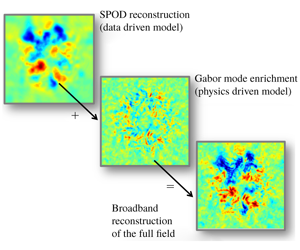Crossref Citations
This article has been cited by the following publications. This list is generated based on data provided by
Crossref.
Habibi, Milad
Dawson, Scott T. M.
and
Arzani, Amirhossein
2020.
Data-Driven Pulsatile Blood Flow Physics with Dynamic Mode Decomposition.
Fluids,
Vol. 5,
Issue. 3,
p.
111.
Ghate, A. S.
and
Lele, S. K.
2020.
Gabor mode enrichment in large eddy simulations of turbulent flow.
Journal of Fluid Mechanics,
Vol. 903,
Issue. ,
Nekkanti, Akhil
and
Schmidt, Oliver T.
2021.
Frequency–time analysis, low-rank reconstruction and denoising of turbulent flows using SPOD.
Journal of Fluid Mechanics,
Vol. 926,
Issue. ,
Ghate, Aditya S.
Kenway, Gaetan K.
Stich, Gerrit-Daniel
Browne, Oliver M.
Housman, Jeffrey A.
and
Kiris, Cetin C.
2021.
Transonic lift and drag predictions using Wall-Modelled Large Eddy Simulations.
Stich, Gerrit-Daniel
Housman, Jeffrey A.
Ghate, Aditya S.
and
Kiris, Cetin C.
2021.
Jet Noise Prediction with Large-Eddy Simulation for Chevron Nozzle Flows.
Martin, Benjamin
Duchaine, Florent
Gicquel, Laurent
and
Odier, Nicolas
2021.
Generation of Realistic Boundary Conditions at the Combustion Chamber/Turbine Interface Using Large-Eddy Simulation.
Energies,
Vol. 14,
Issue. 24,
p.
8206.
Hass, Ryan D.
Ghate, Aditya S.
and
Lele, Sanjiva K.
2021.
Subgrid-scale pressure field of scale-enriched large eddy simulations using Gabor modes.
Physical Review Fluids,
Vol. 6,
Issue. 12,
Hass, Ryan
Ghate, Aditya S.
and
Lele, Sanjiva K.
2021.
LES Scale Enrichment and its Effect on the Pressure Field.
Schmidt, Oliver T.
2022.
Spectral proper orthogonal decomposition using multitaper estimates.
Theoretical and Computational Fluid Dynamics,
Vol. 36,
Issue. 5,
p.
741.
Stich, Gerrit-Daniel
Ghate, Aditya S.
Housman, Jeffrey A.
and
Kiris, Cetin C.
2022.
Wall Modeled Large Eddy Simulations for NASA's jet noise consensus database of single-stream, round, convergent jets..
Lario, Andrea
Maulik, Romit
Schmidt, Oliver T.
Rozza, Gianluigi
and
Mengaldo, Gianmarco
2022.
Neural-network learning of SPOD latent dynamics.
Journal of Computational Physics,
Vol. 468,
Issue. ,
p.
111475.
Nidhan, Sheel
Schmidt, Oliver T.
and
Sarkar, Sutanu
2022.
Analysis of coherence in turbulent stratified wakes using spectral proper orthogonal decomposition.
Journal of Fluid Mechanics,
Vol. 934,
Issue. ,
Zhang, Jinhao
Shi, Lijuan
Tang, Zhanqi
Ma, Xingyu
and
Jiang, Nan
2023.
Influence of hemisphere disturbance on laminar boundary layer at low Reynolds numbers.
Physics of Fluids,
Vol. 35,
Issue. 10,
Wong, Tsz Y.M.
Stavropoulos, Michael N.
Beekman, Jayson R.
Towne, Aaron
Nogueira, Petrônio A.S.
Weightman, Joel
and
Edgington-Mitchell, Daniel
2023.
Steady and unsteady coupling in twin weakly underexpanded round jets.
Journal of Fluid Mechanics,
Vol. 964,
Issue. ,
Mondal, Kingshuk
Kethavath, Naveen N.
Abhinay, Kondu
and
Ghaisas, Niranjan S.
2023.
Large Eddy Simulation Study of Atmospheric Boundary Layer Flow over an Abrupt Rough-to-Smooth Surface Roughness Transition.
Boundary-Layer Meteorology,
Liu, Han
Xiao, Zuoli
and
Shen, Lian
2023.
Simulation-based study of low-Reynolds-number flow around a ventilated cavity.
Journal of Fluid Mechanics,
Vol. 966,
Issue. ,
Arun, Rahul
Bae, H. Jane
and
McKeon, Beverley J.
2023.
Towards real-time reconstruction of velocity fluctuations in turbulent channel flow.
Physical Review Fluids,
Vol. 8,
Issue. 6,
Song, Hang
Wong, Man Long
Ghate, Aditya S.
and
Lele, Sanjiva K.
2024.
Numerical study of transonic laminar shock buffet on the OALT25 airfoil.
Thirunavukkarasu, Arvind
Sundar, Rahul
and
Sarkar, Sunetra
2024.
Comparative analysis of model reduction techniques for flapping wing dynamics.
Physics of Fluids,
Vol. 36,
Issue. 6,
Thirunavukkarasu, Arvind
Sundar, Rahul
and
Sarkar, Sunetra
2024.
Fluid Mechanics and Fluid Power, Volume 3.
p.
705.


